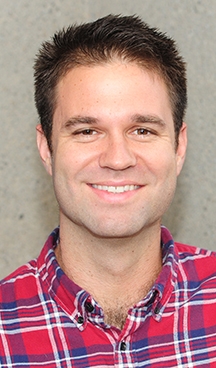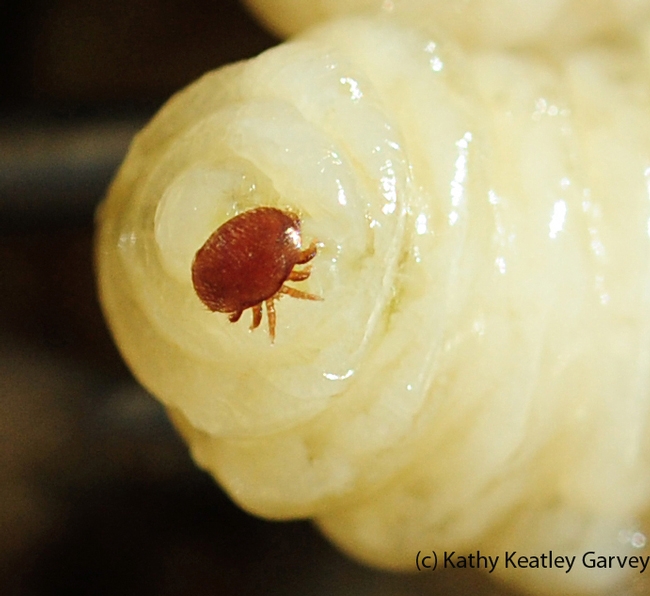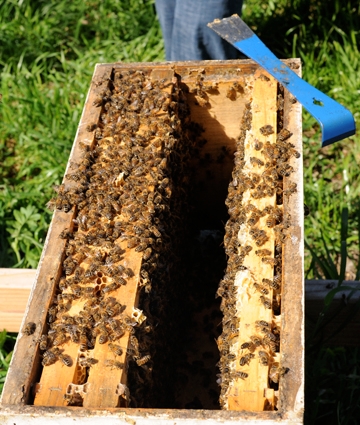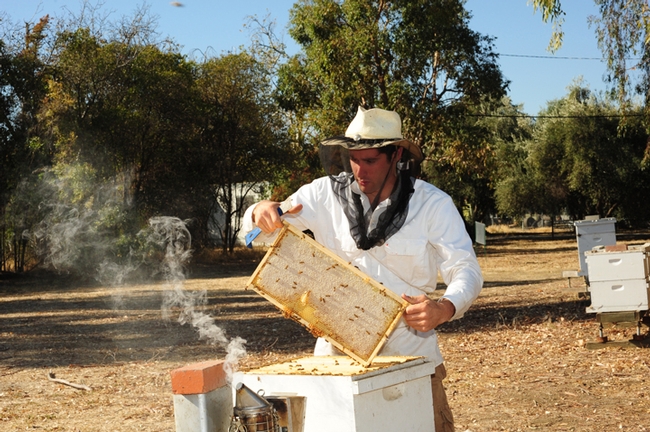- Author: Kathy Keatley Garvey

As an undergraduate at the University of Illinois, Urbana-Champaign, he enrolled in an introductory entomology class. “I remember seeing the research technician standing in and indoor flight cage, surrounded by bees,” Nye said. “They were flying from the hive to a feeder stand and completely ignoring her. We covered the long history of beekeeping in that class around that same time and I was just amazed at how much knowledge had been collected. I applied for a job and started working as an assistant to the research technician I saw that day that spring. I spent the next three summers working for the lab of Dr. Gene Robinson and learning as much as I could.”
He went on to spend eight years in Illinois working with the bees—three as an undergraduate assistant and five years as the facility manager and research technician. He joined UC Davis in December 2015.
“Adapting to the California ecosystem has been a bit of an adjustment,” Nye said. “A big part of beekeeping is understanding the ecosystem you live in. If you've got a bee yard that doesn't have a water source close, you may need to move water in during dry periods. Different flowers provide nectar and pollen at varying quantities, so being aware of what's going on in the environment can give you some insight into whether or not you might need to assist your bees with some sugar to make it until the next bloom. That has honestly been my favorite part of moving here, learning about all the trees and shrubs and wildflowers and when they bloom. It's a constant process through the year, and being my first year here it's been really enjoyable to watch the seasons progress."
Nye welcomes the worldwide interest in bees and the crucial role they play. “I think people are starting to understand the complex role bees play in our food system, and I hope in the future we could help educate people about how the agricultural system is helped by natural areas,” he said. “Here in the Central Valley, there is very little unused space. We are able to bring in honey bees on trucks from distant areas to pollinate our crops, but it's a very precarious system that we are relying on to make that work. Having some natural corridors for pollinators year round would really help increase the population of native bees, help the health of honey bees, and keep us from worrying about losing the delicate balance we are keeping between honey bees and agricultural production.”
"I think the general public's knowledge of bees has made amazing advances in recent years. The shortage of bees for agricultural purposes here in the Central Valley really brought beekeeping into the news, followed by a lot of documentaries and things that made people want to be beekeepers or at least plant pollinator friendly gardens. Lots of people bring up beekeeping documentaries they've seen, and I don't think beekeepers were experiencing that 20 years ago. Overall, I'm mostly impressed with the amount of bee related knowledge out in the world right now.
Myths and misconceptions about bees? Often people associate bees with stinging, and falsely claim they have an allergy. “I've been doing this long enough that I don't laugh at people when they tell me they are allergic, but I think people don't completely understand what allergic means,” he said. “Only one or two people out of 1000 are actually allergic and have a life threatening reaction--most people just experience pain and swelling. I try to point out to people that when it hurts and makes their hand swell up, that might not mean they have a bee allergy, but most of the time I just nod my head and move on. I worked a booth at a local fair and half my conversations were people telling me they were allergic because it hurt. I get stung every day, and I can attest that at no point does it stop hurting.”
Nye divides his time with the labs of Extension apiculturist Elina Niño, pollination ecologist Neal Williams, and Brian Johnson, who studies the behavior, evolution and genetics of honey bees. “My responsibilities are pretty spread out,” he said. “The majority of my time is spent keeping the bees healthy enough for experiments.” In peak season, “it's pretty common to just have a few weeks' notice that we need any number of healthy full sized colonies, and like other animals, you can't grow a calf to a full sized cow with any magic tricks, so we try to buffer that by keeping a tight schedule for disease monitoring and making sure all our colonies are as robust as possible.”
What does he like the best about his job? The least?
"My job has a great balance between working out in a natural setting going through bee hives, and coming back to the lab and getting involved in research," he said. "I think doing either one of them by themselves would get a little tedious for me, so I feel really lucky to be able to split myself between the two. The least? It might be kind of a strange complaint, but foxtails. I spend a lot of time walking through tall grass and those foxtails burrow into my shoes and make me crazy. And I'm told I have to worry about them going up my dog's nose? I would say it's an urban myth but the seeds ability to get into my shoe and under my sock is practically magic."
(Editor's Note: For a list of the 2017 apiculture courses that the Niño lab is offering and teaching, see this page.)



- Author: Kathy Keatley Garvey

Participants may register for one or both courses, according to Extension apiculturist Elina Niño, who is coordinating and teaching the courses with Bernardo Niño and colleagues at the Harry H. Laidlaw Jr. Honey Bee Research Facility.
Each course will take place from 9 a.m. to 5 p.m. at the Laidlaw facility, located on Bee Biology Road, west of the central campus. The maximum number of participants per course is 25.
Planning Ahead for Your First Hive
The course, “Planning Ahead for Your First Hives,” taught by Elina Niño, Bernardo Niño, Charley Nye and Tricia Bohls, will provide lectures and hands-on exercises. The course is described as “perfect for those who have little or no beekeeping experience and would like to obtain more knowledge and practical skills before moving on to the next step of owning and caring for their own honey bee colonies.”
Lecture modules will cover honey bee biology, beekeeping equipment, how to start your colony, and maladies of the hive. Practical modules will zero in on how to build a hive, install a package, inspect a hive and monitor for varroa mites.
Participants will have the opportunity to learn about and practice many aspects of what is necessary to get the colony started and keep it healthy and thriving. At the end of the course, participants "will be knowledgeable about installing honey bee packages, monitoring their own colonies and taking on possible challenges with maintaining a healthy colony."
The $95 registration fee covers the cost of course materials (including a hive tool), lunch and refreshments.
Working Your Colonies
For the short course, “Working Your Colonies,” instructors are Elina Niño and Bernardo Niño. The course, to include lectures and hands-on exercises, is described as “perfect or those who already have beekeeping experience and would like to obtain more knowledge and practical to move on to the next step of managing and working their own honey bee colonies.”
Lecture modules will include advanced honey bee biology, honey bee integrated pest management and products of the hive. Practical modules will cover queen wrangling, honey extraction, combining colonies, splitting colonies and monitoring for varroa mites. The $150 registration fee covers the cost of course materials, lunch, and refreshments.
For each course, participants are asked to bring a bee suit or veil if they have one (the lab has a limited number). Lodging is not provided. For more information on registering for the short courses, contact Bernardo Niño at elninobeelab@gmail.com or (530) 380-BUZZ (2899). See lab's Facebook page.


- Author: Kathy Keatley Garvey

Bohls, a first-year doctoral student in the UC Davis Department of Entomology and Nematology, received a $1000 prize. The two-day symposium took place April 7-8 in the UC Davis Conference Center.
Bohls began her presentation, “Efficacy of Several Biopesticides Against Varroa Mites,” with a brief overview of honey bees, discussed their importance and why they are dying, and then turned to her research on mite infestation. She studies with state Extension apiculturist Elina Niño of the department's Harry H. Laidlaw Jr. Honey Bee Research Facility.
Bohls' abstract: "Varroa destructor is an ectoparasitic mite on Apis mellifera; it feeds on hemolymph and vectors several pathogens. The purpose of this efficacy and safety trial was to determine the level of Varroa mite control provided by several biopesticides in a systems approach and to determine the safety to bees and honey yield variables. These experiments were conducted at the Harry H. Laidlaw Jr. Honey Bee Research Facility. Five groups of eight to ten established colonies with infestations of Varroa mites were selected for the experiments. All colonies were contained within the same apiary and began with 2 percent mite levels. Each of the five groups of honey bee colonies were randomly assigned a treatment: positive control, Product A (low and high dose), Product B, untreated control. The level of Varroa mite infestation was determined with an alcohol wash prior to the treatment, three times during, and at the end of the treatment. Effects on colony strength were measured by counting the number of frames of adult bees, brood, honey, and pollen before, during, and after the treatment."

A native of Macedonia, Ohio, Bohls joined the UC Davis doctoral program last fall. She is involved with public outreach and extension in the Niño lab, assisting with beekeeping workshops and short courses. She recently delivered a presentation to the American Honey Producers' Association convention.
Bohls received her bachelor's degree from Hiram (Ohio) College in May 2015, double-majoring in neuroscience and environmental studies and minoring in biology. In independent studies at Hiram, she conducted a wasp survey at the James H. Barrow Field Station, comparing wasp diversity in newer vs. older growth forests. She also served as a research assistant with Thomas Koehnle at the field station where she studied eastern gray squirrels with a variety of population sampling procedures, including home range studies, time area counts, and transects. She conducted an anti-predator behavior study on the eastern gray squirrel, extensively comparing the behavior of the two color morphs of the eastern gray squirrel.
In addition, Bohls developed a citizen science butterfly program at the field station. As a research assistant, Bohls worked on a butterfly population study at the field station's Monarch Waystation, comparing the population and species differences of butterflies in a field before and after a controlled burn.
- Author: Kathy Keatley Garvey

Course instructors are Extension apiculturist Elina Lastro Niño; staff research associate Bernardo Niño; facility manager/staff research associate Charley Nye; and graduate student Tricia Bohls. All courses, open to the public, will be taught at the Laidlaw facility, located on Bee Biology Road, west of the UC Davis central campus.
The courses are:
“Planning Ahead for Your First Hive”: A short course on Saturday, Feb. 13 for those with little or no beekeeping experience;
“Working Your Colonies”: A short course on Saturday, Feb. 20 for novice beekeepers, or those who already have a colony and want to develop more skills; and
“Queen-Rearing Techniques” with two separate sessions: Saturday and Sunday, March 12-13 and Saturday and Sunday, March 19-20. This course is for beekeepers who want to learn how to rear their own queens or learn bee breeding.
Capsule Information:
“Planning Ahead for Your First Hives”: This Feb. 13th course will include lectures and hands-on exercises. “This course is perfect for those who have little or no beekeeping experience and who would like to obtain more knowledge and practical skills to move on to the next step of owning and caring for their own honey bee colonies,” said Elina Niño. Lectures will cover honey bee biology, beekeeping equipment, how to start your colony, and maladies of the hive. Hands-on exercises will cover how to build a hive, how to install a package, how to inspect your hive, and how to monitor for varroa mites. Participants will learn what is necessary to get the colony started and keep it healthy and thriving, she said. By the end of the course, participants will be knowledgeable about installing honey bee packages, monitoring their own colonies and maintaining a healthy colony. The $95 registration fee covers the cost of course materials (including a hive tool), lunch, and refreshments.
“Working Your Colonies”: This Feb. 20th course is for novice beekeepers who already have a colony and/or have taken a previous course, and seek to develop their skills. The afternoon will be spent entirely in the apiary with hands-on activities and demonstrations. Lectures will cover: maladies and biology review, products of the hive, and troubleshooting problems in the colony. Hands-on information will encompass colony evaluations, monitoring and managing pests, feeding your colony, and honey extraction.By the end of the course, participants will be knowledgeable about evaluating colonies, solving common beekeeping problems, extracting honey and wax, trapping pollen and propolis, and treating colonies for pests, the instructors said. The $150 registration fee covers the cost of course materials, lunch, and refreshments.
“Queen-Rearing Techniques”: Each of the two sessions, March 12-13 and March 19-20, will include lectures, hands-on exercises. Topics will include honey bee queen biology, basics of selective honey bee breeding programs, various queen-rearing techniques, testing hygienic behavior, and assessing varroa mite levels.
Participants will have the opportunity to learn about and practice multiple methods for queen rearing. “We will go through a step-by-step process for queen rearing via grafting, including setting up cell builders and mating nucs,” Elina Niño said. At the end of the course, participants will be able to check their grafting success and local participants can take home queen cells from the workshop. They also will learn techniques to assess varroa mite loads and to evaluate hygienic behavior. Each session also will include a guided tour of the adjacent Häagen-Dazs Honey Bee Haven, a half-acre bee friendly garden that attracts many pollinators and is filled with art from the UC Davis Art/Science Fusion Project and entomology/art classes taught by Diane Ullman and Donna Billick.
The $350 registration fee for each queen-rearing session covers the cost of course materials (including a set of grafting equipment: grafting frame with bars, plastic queen cups and a grafting tool), breakfast, lunch and refreshments on the days of the short course.
All participants in the Feb. 13-March 20 courses should bring their own bee suits or veils. They are also responsible for obtaining their own lodging. See map for directions. For more information, contact Bernardo Niño at elninobeelab@gmail.com or call 530-380-BUZZ (2899).
The Niño lab website is at http://elninobeelab.ucdavis.edu/, and the Facebook page at https://www.facebook.com/elninolab/. The bi-monthly apiculture newsletter, written by Elina Niño, is online.



- Author: Kathy Keatley Garvey

Staff research associate/beekeeper Billy Synk worked with and assisted photographer Anand Varma's needs for a year in the development of the illustrated article. Extension apiculturist emeritus Eric Mussen, who retired last June after 38 years of service, served as a research fact-checker, contacted by National Geographic.
The article, authored by Charles Mann asked “Can the world's most important pollinators be saved?' and pondered “how scientists and breeders are trying to create a hardier honeybee.”
Varma's time-lapse video of 2500 images, showing the development of eggs to pupae to adults, was filmed at the Laidlaw apiary. Two still photos, of a bee in flight, and a close-up of an emerging worker bee, were also taken in the Laidlaw apiary.
In his article, Mann touches on RNAi and quotes bee researcher Marla Spivak of the University of Minnesota and recipient of a MacArthur Foundation “genius grant” as saying “If you target one specific area, the organism will always make an end run around it.” She advocates a “healthier, stronger” bee, or what Mann writes as “one that can fight (varroa) mites and disease on its own, without human assistance.”
Spivak was the keynote speaker at the Bee Symposium, hosted May 9 by the Honey and Pollination Center in the UC Davis Conference Center. It drew a crowd of 360.
Spivak and John Harbo of the USDA's research center in Baton Rouge, La. “both succeeded in breeding versions of hygienic bees by the late 1990s,” Mann writes. “A few years after that, scientists realized that hygienic bees are less effective as the mites grow more numerous.”
Both Spivak and Varma have presented TED talks on honey bees.
Spivak: Why Bees Are Disappearing
Varma: A Thrilling Look at the First 21 Days of a Bee's Life




